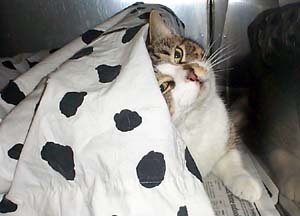Why Do Cats Purr?

Why and how do cats purr?
No one knows for sure why a domestic cat purrs, but many people interpret the sound as one of contentment. Our understanding of how a domestic cat purrs is becoming more complete; most scientists agree that the larynx (voice box), laryngeal muscles, and a neural oscillator are involved.
Kittens learn how to purr when they are a couple of days old. Veterinarians suggest that this purring tells ‘Mom’ that “I am okay” and that “I am here.” It also indicates a bonding mechanism between kitten and mother.
As the kitten grows into adulthood, purring continues. Many suggest a cat purrs from contentment and pleasure. But a cat also purrs when it is injured and in pain. Dr. Elizabeth Von Muggenthaler has suggested that the purr, with its low frequency vibrations, is a “natural healing mechanism.” Purring may be linked to the strengthening and repairing of bones, relief of pain, and wound healing (See Web link to Felid purr: a healing mechanism).
Purring is a unique vocal feature in the domestic cat. However, other species in the Felidae family also purr: Bobcat, Cheetah, Eurasian Lynx, Puma, and Wild Cat (Complete list in Peters, 2002). Current studies show that Pantherinae subfamily: Lion, Leopard, Jaquar, Tiger, Snow Leopard, and Clouded Leopard do not have purring (Peters, 2002).
What makes the purr distinctive from other cat vocalizations is that it is produced during the entire respiratory cycle (inhaling and exhaling). Other vocalizations such as the “meow” are limited to the expiration of the breath.
It was once thought that the purr was produced from blood surging through the inferior vena cava, but as research continues it seems that the intrinsic (internal) laryngeal muscles are the likely source for the purr. Moreover, there is an absence of purring in a cat with laryngeal paralysis. The laryngeal muscles are responsible for the opening and closing of the glottis (space between the vocal chords), which results in a separation of the vocal chords, and thus the purr sound. Studies have shown, that the movement of the laryngeal muscles is signaled from a unique “neural oscillator” (Frazer-Sisson, Rice, and Peters, 1991 & Remmers and Gautier, 1972) in the cat’s brain.




0 Comments:
Post a Comment
<< Home